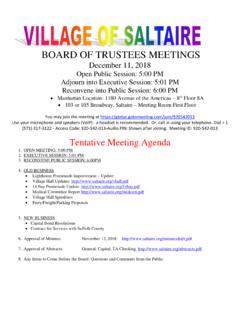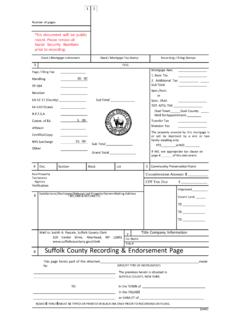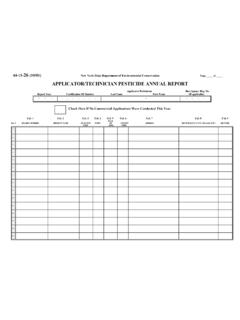Transcription of Chapter 20 COASTAL EROSION HAZARD AREA §20 …
1 COASTAL EROSION . 20-1. 20-1. Chapter 20. COASTAL EROSION HAZARD area . 20-1. Enactment 20-2. Title 20-3. Effective Date 20-4. Purpose 20-5. Findings 20-6. Definitions 20-7. Areas 20-8. Requirements 20-9. General Standards 20-10. Structural HAZARD area Restrictions 20-11. Nearshore area Restrictions 20-12. Beach area Restrictions 20-13. Dune area Restrictions 20-14. EROSION Protection Structure Requirements 20-15. Traffic Control 20-16. Applicability 20-17. Emergency Permit 20-18. Cessation of Unjustified Activities; Remedies 20-19. Variances from Standards and Restrictions 20-20. Format and Procedure 20-21. Fees 20-22. Expiration 20-23. COASTAL EROSION HAZARD Board of Review 20-24. Appeal 20-25. Appeal to the Court 20-26. COASTAL EROSION Management Permits 20-27. Bonds 20-28. Administrator 20-29. Interpretation 20-30.
2 Conflicts 20-31. Severability 20-32. Environmental Review 20-33. Violations and Penalties 20-34. Procedure 20-35. Commissioner Approval 20-36. Recording PREFACE. 2001. 11-20-06. SALTAIRE CODE. 20-1. 20-4. This Local Law was adopted by the Village of Saltaire to facilitate local government assumption of authority and responsibility for enforcing and administering the COASTAL EROSION HAZARD Areas Act of 1981, codified as Article 34. of the New York State Environmental Conservation Law. This Local Law is intended to meet the COASTAL EROSION Management Regulations, 6 NYCRR Part 505, adopted by the Commissioner of Environmental Conservation on March 18, 1983 and subsequently amended to incorporate legislative mandates of 1985.]. [HISTROY: Adopted by the Board of Trustees of the Village of Saltaire 3-10-99 as No. 2, 1999].
3 ARTICLE I. INTRODUCTION. 20-1. Enactment Pursuant to the provisions of Article 34 of the New York State Environmental Conservation Law and Section 10 of the Municipal Home Rule Law, the Village of Saltaire, county of suffolk , State of New York, hereby enacts by local law #2 of 1999, this local law. 20-2. Title This local law shall be known and may be cited as the Village of Saltaire COASTAL EROSION HAZARD area Law. 20-3. Effective Date This local law shall take effect twenty (20) calendar days from March 10, 1999, which is the date of this local law's adoption and filing pursuant to Section 27 of the Municipal Home Rule Law, or the date of filing the official maps, whichever is later. 20-4. Purpose The Village of Saltaire hereby assumes the responsibility and authority to implement and administer a COASTAL EROSION management program within its jurisdiction pursuant to Article 34 of New York State Environmental Conservation Law.
4 In addition, it is the purpose of this local law to: a. Establish standards and procedures for minimizing and preventing damage to structures from COASTAL flooding and EROSION and to protect natural protective features and other natural resources. b. Regulate in COASTAL areas subject to COASTAL flooding and EROSION , land use and development activities so as to minimize or prevent damage or destruction to man-made property, natural protective features, other natural resources, and to protect human life. c. Regulate new construction or placement of structures in order to place them a safe distance from areas of active EROSION and the impacts of COASTAL storms to ensure that these structures are not prematurely destroyed or damaged due to improper siting, as well as to prevent damage to natural protective features and other natural resources.
5 2002. 11-20-06. COASTAL EROSION . 20-5. 20-6. d. Restrict public investment in services, facilities, or activities which are likely to encourage new permanent development in EROSION HAZARD areas. e. Regulate the construction of EROSION protection structures in COASTAL areas subject to serious EROSION to assure that when the construction of EROSION protection structures is justified, their construction and operation will minimize or prevent damage or destruction to man-made property, private and public property, natural protective features, and other natural resources. 20-5. Findings The Village of Saltaire finds that the COASTAL EROSION HAZARD area : a. Is prone to EROSION from action of the Atlantic Ocean. Such EROSION may be caused by the action of waves, currents running along the shore, and wind-driven water and ice.
6 Such areas are also prone to EROSION caused by the wind, runoff of rain water along the surface of the land, or groundwater seepage, as well as by human activities such as construction, navigation and certain forms of recreation. b. Experiences COASTAL EROSION which causes extensive damage to publicly and privately owned property and to natural resources as well as endangering human lives. When this occurs, individuals and private businesses suffer significant economic losses, as do the Village of Saltaire and the State economies, either directly through property damage or indirectly through loss of economic return. Large public expenditures may also be necessitated for the removal of debris and damaged structures and replacement of essential public facilities and services. c. Experiences EROSION -related problems that may be contributed to by man's building without considering the potential for damage to property, by undertaking activities which destroy natural protective features such as dunes or vegetation, by building structures intended for EROSION prevention which may exacerbate EROSION conditions on adjacent or nearby property, and by water action produced by wakes from boats.
7 20-6. Definitions: The following terms used in this local law have the meanings ascribed to them in 6 NYCRR Part 505 promulgated by the New York State Department of Environmental Conservation, unless the context clearly requires otherwise. a. ADMINISTRATOR -- The local official responsible for administering and enforcing this local law. The powers and duties of this position are more fully described in b. BEACH -- The zone of unconsolidated earth that extends landward from the mean low water line to the waterward toe of a dune. Where no dune exists landward of a beach, the landward limit of a beach is 100 feet landward from the place where there is a marked change in material or physiographic form or from the line of permanent vegetation, whichever is most 2003. 11-20-06. SALTAIRE CODE. 20-6. 20-6. waterward. Shorelands subject to seasonal or more frequent overwash or inundation are considered to be beaches.
8 C. COASTAL EROSION HAZARD area MAP -- The final map and any amendments thereof issued by the Commissioner of the New York State Department of Environmental Conservation, which delineates boundaries of COASTAL EROSION HAZARD Areas subject to regulation under Article 34 of the Environmental Conservation Law and this law. d. COASTLINE AND COASTAL WATERS -- The lands adjacent to the Village's COASTAL waters of the Atlantic Ocean is the coastline, including its connecting water bodies, bays, harbors, shallows, and marshes. e. DEBRIS LINE -- A linear accumulation of waterborne debris deposited on a beach by storm induced high water or by wave action. f. DUNE -- A ridge or hill of loose, windblown, or artificially placed earth the principal component of which is sand. g. EROSION -- The loss or displacement of land along the coastline due to the action of waves, currents, wind-driven water, waterborne ice, or other impacts of storms.
9 It also means the loss or displacement of land due to the action of wind, runoff of surface waters, or groundwaters, or groundwater seepage. h. EROSION HAZARD area -- An area of the coastline which is a structural HAZARD area , or a natural protective feature area . i. EROSION PROTECTION STRUCTURE -- A structure specifically designed to reduce or prevent EROSION such as a groin, jetty, revetment, breakwater, or artificial beach nourishment project. j. EXISTING STRUCTURE -- A structure and appurtenances in existence or one where construction has commenced or one where construction has not begun but for which a building permit has been issued prior to the effective date of this local law. k. GRADING -- A redistribution of sand or other unconsolidated earth to effect a change in profile. l. MAJOR ADDITION -- An addition to a structure resulting in a 25 percent or greater increase in the ground area coverage of the structure other than an EROSION protection structure or a pier, dock, or wharf.
10 The increase will be calculated as the ground area coverage to be added, including any additions previously constructed under a COASTAL EROSION Management Permit, divided by the ground area coverage of the "existing structure" as defined in EXISTING. STRUCTURE. 2004. 11-20-06. COASTAL EROSION . 20-6. 20-6. m. MEAN LOW WATER -- The approximate average low water level for a given body of water at a given location, determined by reference to hydrological information concerning water levels or other appropriate tests. n. MEAN HIGH WATER MARK -- The approximate average high water level for a given body of water at a given location, determined by reference to hydrological information concerning water levels or other appropriate tests. o. MOVABLE STRUCTURE -- A structure designed and constructed to be readily relocated with minimum disruption of the intended use.





